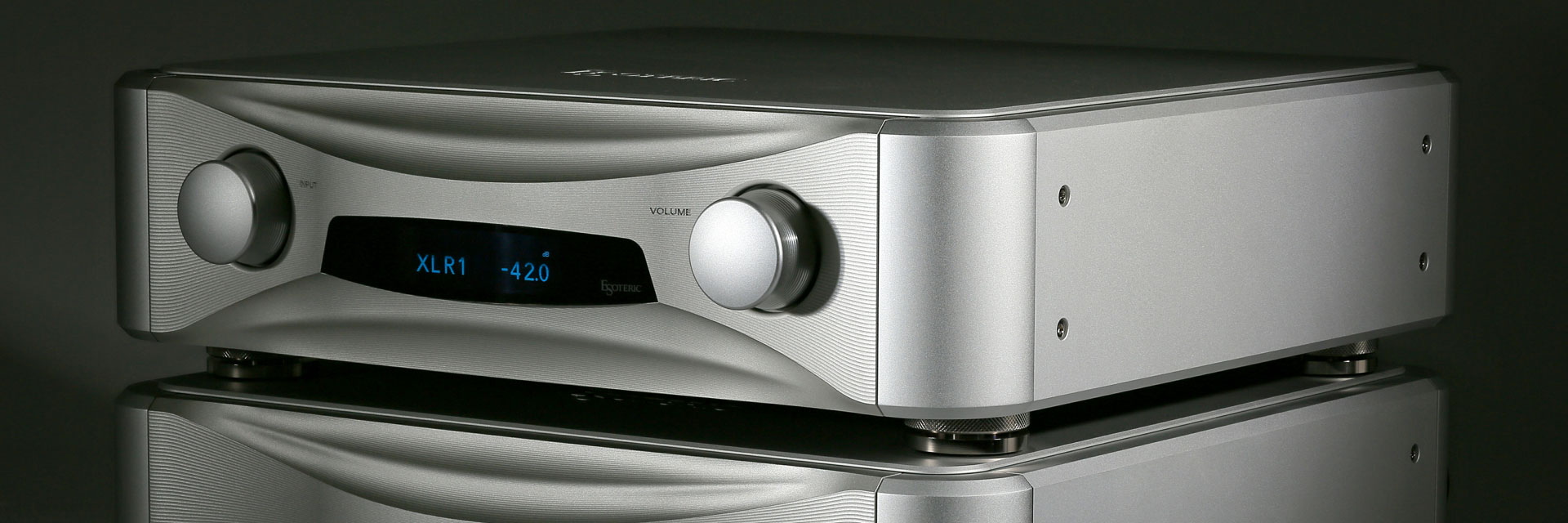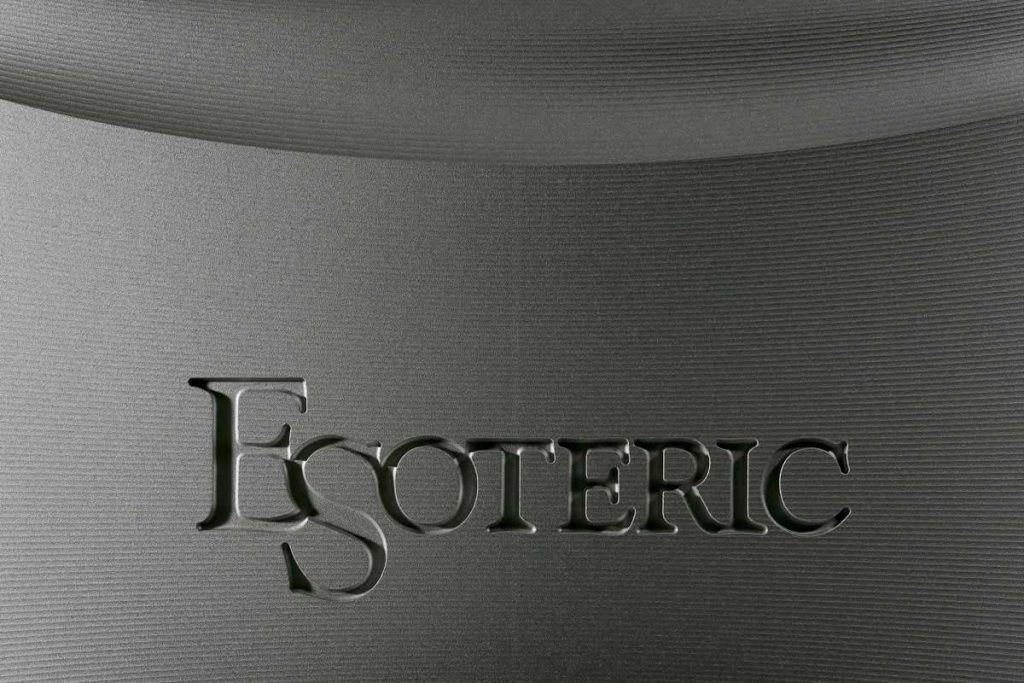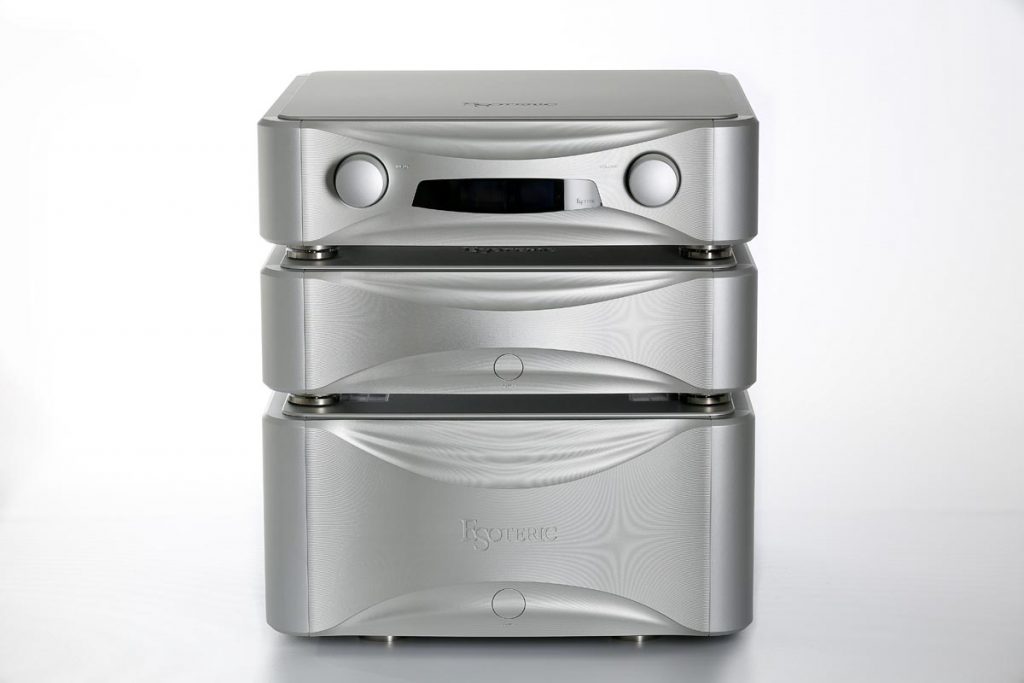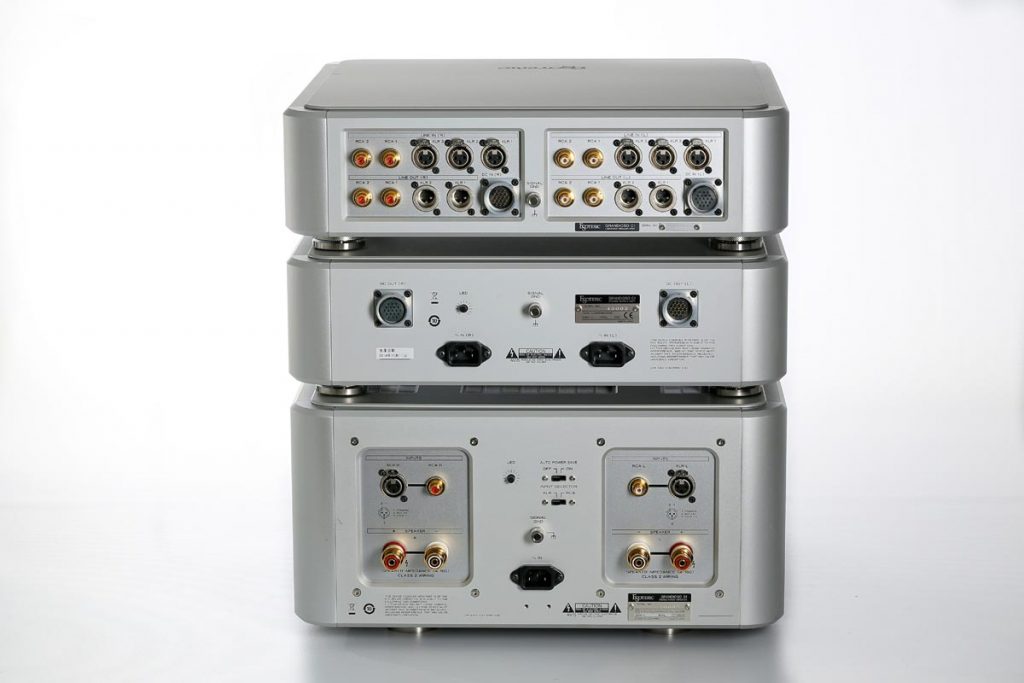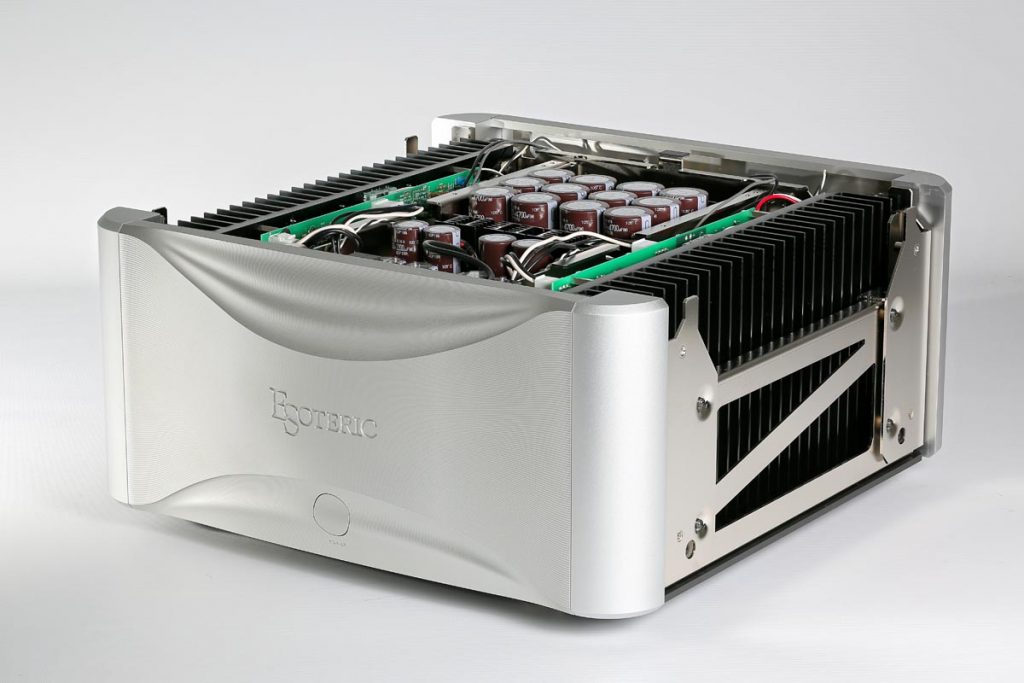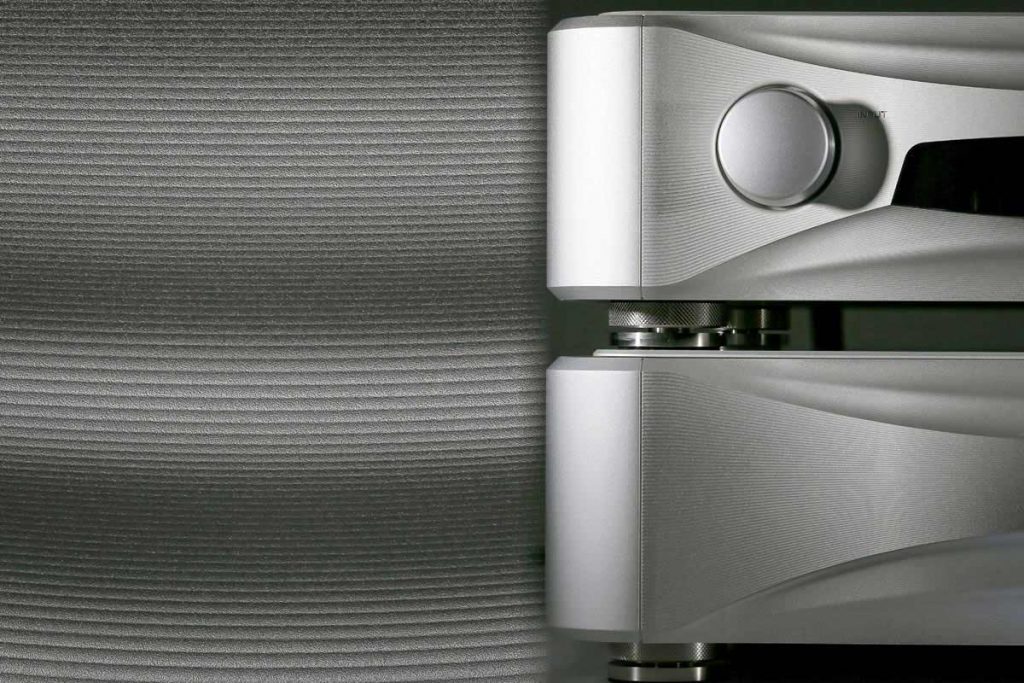Dawn of the Blue Sun
Japan and Italy? Sumo and sculpture? The flagship amplifiers from Esoteric convey an aura of truth and commitment straight from the land of the rising sun. But their name and outward appearance are all italian in style.
What do well-bred amplifiers do each time their masters enter the room? They roll out a carpet of blue light to lead their rulers to the font of truth. To delight the eye, they look attractive. To please the ear, they sound wonderful. Then their masters can thank their lucky stars, make themselves comfortable in their listening chairs and slowly turn up the volume…
There’s no doubt about it. Stepping into the listening room and feeling like the Prince of Hi-Fi is pretty nice from time to time. Especially when nobody’s looking. For a couple of weeks at least, I was able to pretend I was the real owner of this wonderful set of amplifiers. The first thing I did, though, was stare into the fascinating blue light for just a bit longer…
Before I digress even further and enter into esoteric realms, I think I should tell you a little bit more about the origins of these three amplifier units. There are probably few product names that conjure such false associations as this exclusive brand from the renowned TEAC Corporation. By no stretch of the imagination could this Tokyo company be regarded as “esoteric.” What the Esoteric engineers do is apply accepted principles of physics to create top hi-fi electronics that ensure outstanding precision and consistency. Esoteric has established a great reputation among audiophiles, and its parent company is closely linked to aerospace and measurement technologies. At its Tokyo headquarters, Esoteric has a staff of 28. More than half of these people, 16 to be exact, work in R&D, but a team of precisely zero is employed to work on supernatural phenomena or in the area of borderline sciences. Even Esoteric doesn’t have this sort of department. Renowned for its technical excellence, the brand has established a name for itself throughout the world and launched a series of products to round out the top end of its portfolio. The series sets visual as well as linguistic accents and is being expanded on an ongoing basis. The Grandioso line of products uses sculptured front panels in an attempt to combine Japanese precision technology with Italian grandeur. This fusion of modern with classical really works, and the gracefully crafted 3-D front panels really do add more than just a touch of bella Italia. Looking both elegant and dynamic, the precisely tooled aluminum housing is perfectly suited to underlining the sophistication of the musical performance—just as Esoteric intends. And then there’s this mesmerizing blue light…
Let’s start by taking a closer look at the brand-new stereo power amplifier. Despite its relatively modest dimensions – the standard full-size hi-fi format – the Grandioso S1 weights in at almost 50 kilograms. The single on-off button on the aluminum front panel sits flush in the 3-D curve in both operating states. But when you switch the S1 on, it radiates a cone of soft blue light onto the area immediately in front of it. For film enthusiasts, this may be reminiscent of UFOs in old sci-fi films or souped-up cars in US action movies. The indirect blue light on the Grandioso S1 is similarly spectacular, but also has a quality you may find soothing or quite simply “cool.” And you can even adjust it to your own personal preference. Alongside all the usual high-end hi-fi connections, there’s a small knob on the rear of the Grandioso S1 that controls the intensity of the blue light.
I love little extras like this. They often reveal more about the “character” of a device (or its designer) than an extensive test would. Unfortunately, some audiophiles tend to mix “character” with “sound” in their search of and disregard certain aspects completely. A love for detail can be found in other features of the S1 as well, including the small aluminum bracket Esoteric supplies with the power amp. This bracket can be screwed into position on the rear of the unit to support the connector on the power cable. This makes me recall my first encounter with Esoteric and TEAC products: While using a beautifully featured VRDS CD player in the 1990s, I discovered several knobs that enabled me to adjust the opening and closing speed of the tray completely independently of each other. Details like this have nothing at all to do with the sound, but they’re part of the overall experience and great to have.
But let’s get back to the Grandioso S1. A close look inside the housing reveals all the know-how and experience of a technology powerhouse. The elaborate double-walled, low-resonance, sandwich-type chassis is divided into several internal compartments and packed full of components. The central compartment contains a large 2,180-watt transformer that provides the amplifier’s power. A smaller dedicated toroidal transformer supplies the power for the voltage amplification stage and S1 controls. Located above the two transformers is the main circuit board where the power-supply units are flanked by two vertical circuit boards and the drive stages. These feature a three-stage Darlington Circuit with 10 bipolar, high-output LAPTs (linear amplified power transistors) in a push-pull configuration. Esoteric is particularly proud of its newly developed low-impedance coupling that reduces the output impedance from the second stage of the drive section to the final stage. This LIDSC (low-impedance drive-stage coupling) makes it possible to obtain the maximum amplitude within the power supply’s available voltage while minimizing distortion. This LIDSC, or so it is whispered, gives the new S1 stereo power amplifier a loudspeaker drive capability that is very near to that of the M1. Be that as it may, the S1 boasts two complete amplification units living under one and the same roof, which is also evident from the heat sinks on the left and right of the chassis.
The S1 is completely symmetrical, of course, and its specs indicate it performs at an appropriate level. Each time impedance is halved, power is doubled: at 8 ohms, the Grandioso S1 delivers an extremely robust 150 watts, with 300 watts at 4 ohms and 600 watts per channel at 2 ohms. With a damping factor of 1,000, the S1 keeps connected speakers on an extremely short leash. Happily, however, there’s nothing at all aggressive about its performance—quite the contrary. It remains . completely unobtrusive as far as the overall sound is concerned, creating a warm state of symbiosis between music lover and state-of-the-art technology. Or is that caused by the cozy temperature of the chassis after a few hours of operating under the seductive blue light?
The perfect complement to the Grandioso S1 is the Grandioso C1 preamp. It distributes functions and weight over two separate chassis: the power-supply unit weighs 29 kilograms and the main unit weighs 21 kilograms. The power supply attests to the dual-mono design of the C1, with dual AC inputs and DC outputs. It’s fantastic how flexible and easy it is to use these solid-looking multipin connectors that slide effortlessly and snugly into their jacks. Those Japanese aren’t showing even the slightest weakness.
The front panels serve as a further source of tactile enjoyment. Visually, there’s not much to distinguish the power-supply unit from the S1 power amp: an elegant button and an intoxicating blue light—no further features are necessary. The preamp itself, of course, has a more extensive interface. The two solid aluminum knobs use TEAC’s own VRDS drive-mechanism bearing system for their control shafts. This enables silky-smooth rotation with no play at all.
When the unit is on, the knobs are surrounded by a halo of blue light. The centrally located display gives plain text information about all the relevant settings, automatically switching itself off again after a short period. The remote-control unit supplied with the C1 is nothing out of the ordinary, however, apart from the pleasant tactile experience of a leather cover on the reverse side.
My first instinct was to criticize the somewhat coarse increments in the lowest volume-control range, but the C1 counters this by providing five different preset volume curves. What’s more, each of the five inputs can be individually and finely adjusted by up to ±18 decibels. Renaming and balancing is also possible, of course. This means the C1 can deal with just about any application scenario. The preamp controls the output level through four parallel, fully symmetrical networks that TEAC calls the Quad Volume Control System (QVCS). Apart from the QVCS, the C1 also boasts Esoteric highlights such as HCLD (high-current line driver”) and a whole array of EDLCs (electric double-layer capacitors). You don’t need to keep any of this in mind, of course. Nor do you need to know that the music signal in the C1 only really needs to pass through a single operational amplifier—but it’s an excellent one. What you should definitely take note of, however, is that the Grandioso C1 is an extremely polite and well-behaved product—a powerful, high-end device that remains practical to use.
Basically speaking, the Grandioso C1 is a classical stereo preamplifier in a modern—but not new-fangled—guise. A remote controller and electronic control are mandatory items these days, but there’s no place for a DA converter, USB port, network connection or phono board. But who needs them? The Grandioso series already boasts excellent digital source systems in the P1 and D1, and vinyl fans will soon be able to admire a matching phono equalizer. But that’s just a footnote to this review.
Up to now, I haven’t said anything about prices. Yes, they’re quite steep, even for units with these great looks, superb controls and massive weight. On the other hand, the Grandioso series is pretty much perfect. A look under the hood lends final proof to the quality of the outstanding components, amazing attention to detail and Esoteric’s refusal to enter into even the tiniest of compromises. This stubbornness and passion for perfection are really expensive traits, but result in magnificent products like those in the Grandioso series—devices that function so perfectly and bring such a hint of luxury that owners probably terminate any further search for the holy grail of hi-fi.
This realization sets in after the very first day of listening. From that moment on, I waste no further thoughts on the wonderfulness of the blue lighting. Over the next few weeks with Grandioso C1 and S1, the only thing I let seduce me is the music itself.
The trio of devices (weighing a total of over 100 kilograms and requiring no little degree of fitness to move around) fits perfectly into any existing hi-fi system and demonstrates no apparent weaknesses. The preamp keeps a low acoustic profile, simply receiving the signals and passing them on to the appropriate downstream powerhouse – with no hint of coolness or prudishness. If I were forced to attribute character traits to the C1, then I’d have to go for something like “big, powerful and energetic.” It also operates seamlessly with all my other power amps.
Its partner in the Grandioso series, the S1, has a similarly impressive, self-confident disposition. In combination with the KEF LS50, the stereo power amplifier is a strict disciplinarian (little monitors love that!) and can even easily deal with a needy big sister like Reference 1. With its generous, muscular approach, the S1 quickly becomes the bosom buddy of my Stereofone Dura. Later in my basement studio, the S1 almost sends my Live Act Audio LAS 312 into orbit.
So much so that a tongue-in-cheek neighbor would ask me the following morning what live band had been playing in my basement. In the listening room at the office, I connected up the Esoteric devices to all the speakers that were not currently being used in a photo shoot. The result: all the speakers I used (Tannoy, Burmester, TAD and DeVore) took an immediate and audible liking to the classical high-end audio components from Japan. For one short second, however, I almost (deliberately) pushed the S1 to its limit (and the Tannoy Turnberry GR LE set the room booming). But this was the only time I ever spared a thought for the doubly powerful monos in the Grandioso series, and it only lasted for one brief second: the S1 only takes up half as much space as the M1 pair, has an outstandingly authentic sound and definitely provides enough power to meet the needs of each and every audiophile.
In a nutshell, the Grandioso devices from Esoteric are true masterpieces of Japanese engineering. The C1 and S1 look great on paper and sitting on the hi-fi rack, but they also perform magnificently where it really matters to audiophiles—in the listening room! The best of Japan combined with a hint of Italian elegance – who could resist such a pairing? Definitely not me. For people with refined tastes in sound, style and technology (and for aspiring Princes of Hi-Fi), Esoteric’s Grandioso C1 and S1 are serious candidates in any ultimate amplifier decision.
Info and tech details
Preamplifier – Esoteric Grandioso C1
Functional principle: linestage preamplifier | Inputs: 3 x balanced line (XLR), 2 x unbalanced line (cinch) | Input impedance: 10 kΩ | Outputs: 2x balanced (XLR), 2 x unbalanced (cinch) | Output impedance balanced/unbalanced: 66 Ω/47 Ω | Special features: external power supply, dual-mono design, adjustable input level (up to ±18 dB), remote control unit, pinpoint feet, automatic display dimming, adjustable intensity for operating light; extremely elaborate sandwich-type chassis | Casing: aluminum | Dimensions of main unit (W/H/D): 44.5/13.5/46 cm | Dimensions of power unit (W/H/D): 44.5/13.5/46 cm | Weight of main unit: 21 kg | Weight of power unit: 29 kg | Warranty period: two years | Price: 28,000 EUR Power amplifier
Power amplifier – Esoteric Grandioso S1
Functional principle: Stereo power amplifier | Power output (8/4/2 Ω): 2 x 150/300/600 W | Inputs: 1 x balanced (XLR), 1 x unbalanced (cinch) | Outputs: one pair of speakers (screw-type terminals) | Special features: Dual mono design, extremely elaborate sandwich-type chassis, pinpoint feet, adjustable intensity for operating light | Casing: aluminum | Dimensions (W/H/D): 44.5/22.5/50 cm | Weight: 47 kg | Warranty period: two years | Price: 36,000 EUR

